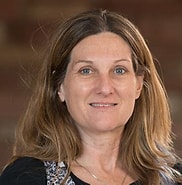
At our noon meeting this past Wednesday, Dr. Susan VandeWoude, since August, 2022, the Dean of CSU’s College of Veterinary Medicine and Biomedical Sciences (CVMBS), shared with us recent accomplishments and current near-term plans of the college. CVMBS, one of eight colleges in CSU, consists of four departments across a range of subjects in veterinary and related fields: Microbiology, Immunology and Pathology; Biomedical Sciences, including Anatomy and Physiology; Environmental & Radiological Health Sciences; and Clinical Sciences. For each of these departments, she spoke about not only their internal contributions and goals but also their connections to the wider community.
Dr. VandeWoude mentioned a number of areas in each of these departments. In the Biomedical Sciences she highlighted studies in animal reproduction and cardiovascular physiology. From the Department of Environmental and Radiological Health Sciences, studies of cancer biology and the Center for Agricultural Health and Safety were addressed. In Clinical Sciences, she pointed out that the College has some 100 faculty members who concentrate on clinical services to patients. Pointing out the cross-disciplinary connections of the College, she highlighted the contributions of the Department of Microbiology, Immunology, and Pathology to routine testing for Covid-19 infection, performing some 300,000 tests at a time when organizations in the human health-care area were able to perform only a fraction of that number.
Continuing the cross-disciplinary connections, she talked about the connection with the CU Anschutz Hospital: CVMBS is the only vet school in the country with imbedded human health-care professionals in the system.
CVMBS trains nearly 1000 undergraduate students as well as the graduate programs in various aspects of veterinary science. The College continues to provide education, in the form of lectures, in the various veterinary and associated disciplines, but there is a concerted on-going effort to improve the way in which the knowledge and practices of the disciplines are presented to the students with more and more emphasis on cross-disciplinary and hands-on experiences. Dr. VandeWoude made the point that the veterinary profession is currently experiencing a significant workforce shortage. She is hopeful that the veterinary aspects of the Spur Campus in Denver, where students will rotate through both to provide vet services to the local community and to gain valuable hands-on experience, will provide a greater understanding of the activities of veterinarians and perhaps attract more young people to the discipline.
For the future, Dr. VandeWoude discussed some plans that are either already in progress or will soon be in process. Perhaps the most visible aspects of this will be the construction of a Veterinary Health and Education Complex added on to the existing Veterinary Teaching Hospital, phase 1 of which should be done sometime in 2026 and phase 2 should start in the 2025 to 2026 time frame. This addition will include a Primary Care Center (thus focusing on preventive care) as well as an Animal Specialty Hospital. There is also an ongoing effort to create a Veterinary Health System with one management team to improve the efficiency of operations of both the facilities and the various medical machines that are used in the College. CVMBS currently grants BS degrees in Biomedical Science and Neuroscience. Plans are underway to construct a Biomedical Discovery Center,that will update main campus facilities to allow expansion of teaching and research programs..
The CSU veterinary program was recently rated #2 in the country by the U S News and World Report survey of vet schools (admittedly a popularity pole of vet schools across the country, but still indicative of the quality and reputation of the school).
Questions:
How much impact does the relationship with Anschutz in Denver have? Dr. VandeWoude made two points. First, the medical students are able to see many more examples of issues that impact humans but as displayed in more abundant animal patients. Second, the students focused on both humans and animals periodically co-populate a clinic at the Murphy Center in north Fort Collins where they provide care to both humans and their animal companions.
Is there any international or even across-state outreach? Is the WICHE program still active? WICHE is still active but getting smaller since some of the participating states have developed their own in-state veterinary programs. CVMBS offers a veterinary externship program in Baja California Sur, and other informal international exchanges take place each year.